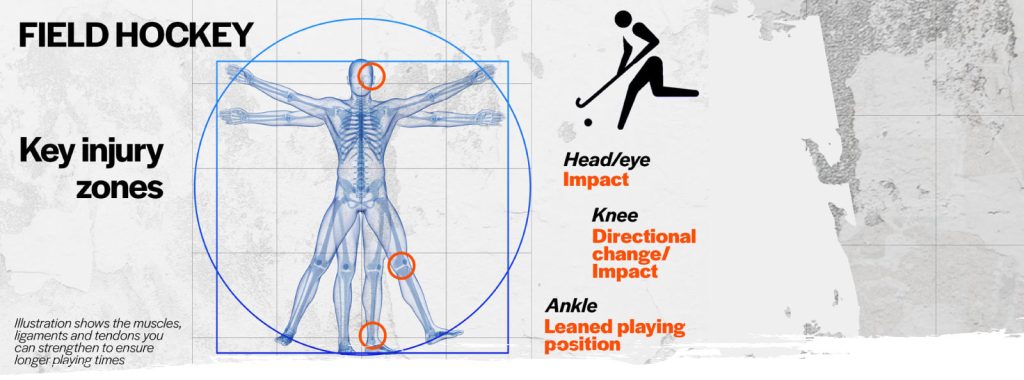Field hockey is one of the oldest team sports still played, with a heritage dating back more than 4000 years! All you need is a small sized ball, some sticks and an open space. Add some friends to play with, and you have a buzzing game that will enhance your reflexes, team building ability and cardiovascular fitness.*
Field hockey does not come without drawbacks. Tackle them with the prevention tips below so that you go back to your favourite sport stronger than ever.
Posture deterioration
Our body is a great machine: it adapts to any task we ask from it. That’s not always a long term advantage. When playing hockey, your posture to control the ball is crunched down. This can lead to a forward shoulder shift (a little “hump” if you want)**. This imbalance is called upper crossed syndrome, and it brings with it a long series of niggles that can prevent you from playing any other sport outside hockey***.
Ankle
A very hockey specific injury is called “deltoid ligament sprain”**. It sounds shoulder-related, but the deltoid ligament connects the lower end of your shin to the upper part of your foot. This is thought to occur due to the hockey player’s forward-leaning position to control the stick and the ball, transferring a huge amount of force to the ankle. Sometimes a sprain can be fairly mild and manifest itself with just some swelling and minor pain. Make sure you don’t keep playing and have a proper rest!
 Knee
Knee
Knees, so often injured in sports! In hockey, as in soccer, sudden changes of direction, uneven ground and long distance running are factors of risk for knee health. It seems that the ACL (anterior cruciate ligament) is the most affected, but MCL (Medial collateral ligament) is also at pretty high risk. The hockey sticks themselves add to this, they can cause damaging impact during games or training.
 Head and Eyes
Head and Eyes
I normally share biomechanical and physiological risks in your team sport, but in the case of hockey we can’t ignore head injuries, eyes damage and sometimes laceration. Research shows that wearing protection is very effective against these accidents and importantly, protection does not undermine performance****.
And now the good news! While we are at home we can work hard to minimise all of the above to happen.
EXERCISES:
Ankle stability
Face a wall with a tennis ball in your hand and balance on one foot. Once perfectly stable, throw the ball against the wall and catch the bounce trying to remain on that foot. You can make it a little harder by going further away from the wall or have somebody else throwing the ball at you at slightly uncomfortable angles. Try to do 3 rounds of 1 minute for each foot.

Once again, balance on one foot. Then, send the other leg straight back and immediately after explosively forward trying to keep a perfect balance. The faster you make the movement, the better, but build speed over time. Repeat for 3 sets of 12 each leg.
Knee strength
With a resistance band around your knees, perform some explosive squats. Make sure that: heels are on the floor all the time except at the very top where you end on your toes; knees are pushing out against the elastic; keep depth below parallel and really squeeze your butt at the top. Do not perform this exercise with a weight.
Posture
To improve your upper body posture, form a triangle shape as shown on the picture. It is ok to bend the legs a little if that makes it a little easier to have your chest and torso in line with arms and hips. Make sure you keep pushing your head and chest through or the stretch will not be as effective. Hold it for 1 minute 3 times.

There is absolutely nothing better than an overhead squat to sort out your posture. In your squat stance, bring a stick above your head – neither in front, nor behind – exactly above your head. Once set, squat as deep as you can. Don’t worry: it might be difficult at the start to go very deep without moving the bar back or forward. Be patient, and build depth over time. Try to do as many good reps as you can in 3-4 minutes.

References
*Hibbert, A. (2010) ‘Strength and Conditioning in Men’s premiership hockey: a case study of understanding, influences and support.’ The University of Birmingham, MPhil thesis.
**Cornelissen, M., Kemler, E., Verhagen, E., Gouttebarge, V. (2020) ‘A systematic review of injuries in recreational field hockey: from injury problem to prevention.’ Journal of Sports Sciences, 38(17), 1953-1974
***Baechle, R. T., Earle, W. R., (2008) Essentials of strength training and conditioning 3rd edition. Champaign: Human Kinetics
****Kriz, P. K. , Zurakowski, D. , Almquist, J. L. , Reynolds, J. , Ruggieri, D. , Collins, C. L. , dHemecourt, P. A. , & Comstock, R. D. (2015). ‘Eye protection and risk of eye injuries in high school field hockey.’ Pediatrics , 136(3), 521–527
Further reading
Postural and Structural Adaptations in Hockey Players [online].
Gidèn, C., Houda, P., Martel, J. (2014) On the Origin of Hockey. London: Hockey Origin Publishing







